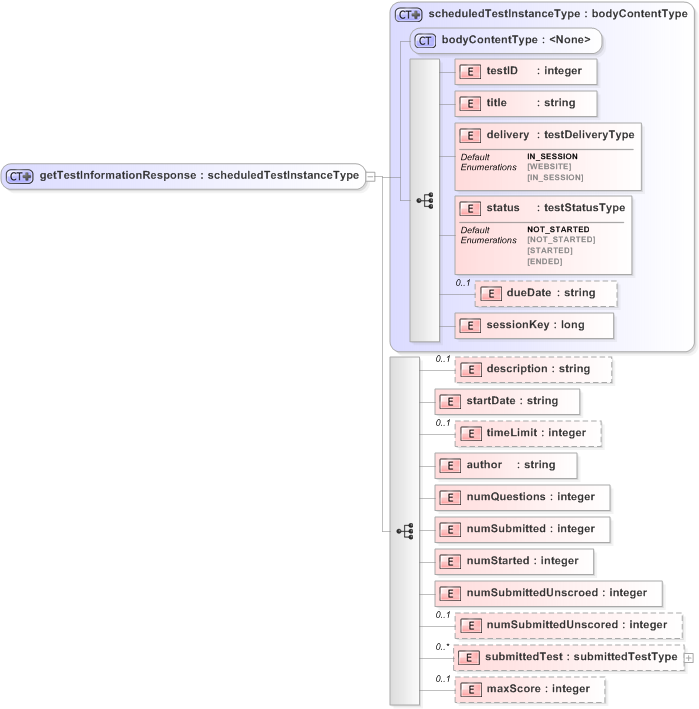GetTestInformation
Returns detailed information for a scheduled test associated with a training session. Information returned includes the names of the
participants who took the test and their grades.
Request
The following schema diagram shows the structure of the elements in the getTestInformation request message.
 |
The sample XML document retrieves detailed information of the test with testID of 202.
<?xml version="1.0" encoding="UTF-8"?>
<serv:message xmlns:xsi="http://www.w3.org/2001/XMLSchema-instance">
<header>
<securityContext>
<webExID>hostid</webExID>
<password>hostpassword</password>
<siteID>0000</siteID>
<partnerID>9999</partnerID>
<email>johnsmith@xyz.com</email>
</securityContext>
</header>
<body>
<bodyContent
xsi:type="java:com.webex.service.binding.training.GetTestInformation">
<testID>202</testID>
</bodyContent>
</body>
</serv:message>
For descriptions of the global elements in the security context of the
header, please see Global Request Elements in Security Context.
For descriptions of the non-global elements, please refer to “Elements
in WebEx XML Schema Definitions for the Training Session Service”.
Response
The following schema diagram shows the structure of the elements in the getTestInformationResponse message.
 |
The sample XML document shows an example of a possible response to the preceding request document.
<?xml version="1.0" encoding="UTF-8"?>
<serv:message xmlns:serv="http://www.webex.com/schemas/2002/06/service"
xmlns:com="http://www.webex.com/schemas/2002/06/common"
xmlns:sess="http://www.webex.com/schemas/2002/06/service/session"
xmlns:train="http://www.webex.com/schemas/2002/06/service/trainingsession"
xmlns:qti="http://www.webex.com/schemas/2002/06/service/trainingsessionqti"
xmlns:qtiasi=
"http://www.webex.com/schemas/2002/06/service/trainingsessionqtiasi">
<serv:header>
<serv:response>
<serv:result>SUCCESS</serv:result>
<serv:gsbStatus>PRIMARY</serv:gsbStatus>
</serv:response>
</serv:header>
<serv:body>
<serv:bodyContent xsi:type="train:getTestInformationResponse"
xmlns:xsi="http://www.w3.org/2001/XMLSchema-instance">
<train:testID>26007</train:testID>
<train:title>Webex employee test (2)</train:title>
<train:delivery>WEBSITE</train:delivery>
<train:status>NOT_STARTED</train:status>
<train:dueDate>05/19/2010 19:05:00</train:dueDate>
<train:sessionKey>901674008</train:sessionKey>
<train:description>To the webex employee test.</train:description>
<train:startDate>05/12/2010 19:05:00</train:startDate>
<train:timeLimit>30</train:timeLimit>
<train:author>bill</train:author>
<train:numQuestions>5</train:numQuestions>
<train:numSubmitted>0</train:numSubmitted>
<train:numStarted>0</train:numStarted>
<train:numSubmittedUnscroed>0</train:numSubmittedUnscroed>
<train:numSubmittedUnscored>0</train:numSubmittedUnscored>
<train:maxScore>0</train:maxScore>
</serv:bodyContent>
</serv:body>
</serv:message>
The result and exceptionID global elements allow you to confirm that an instantiation request was successful. See Global Response Elements Showing Results and Errors.